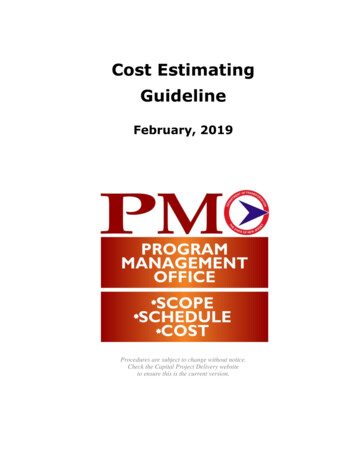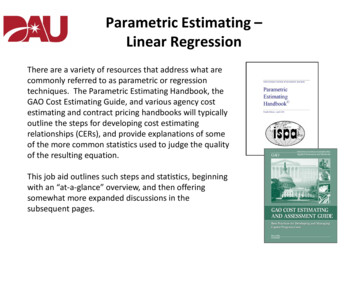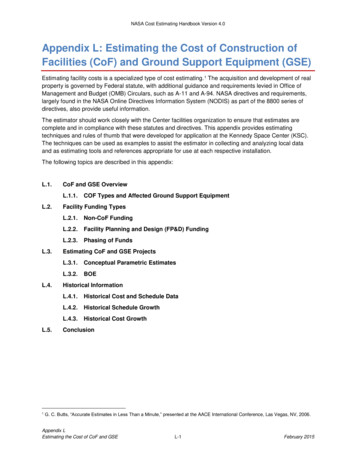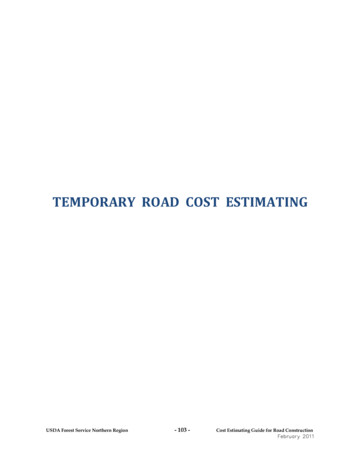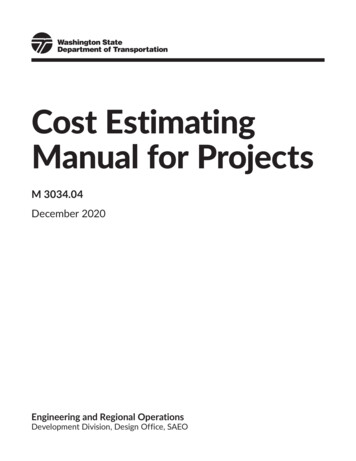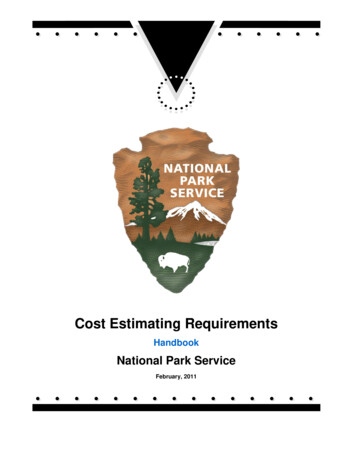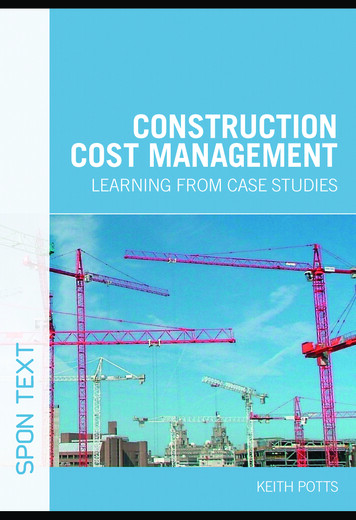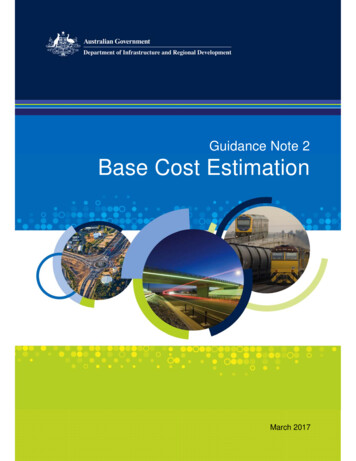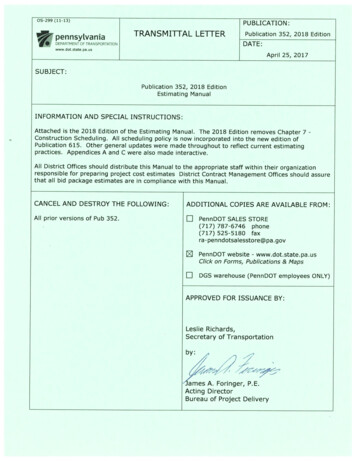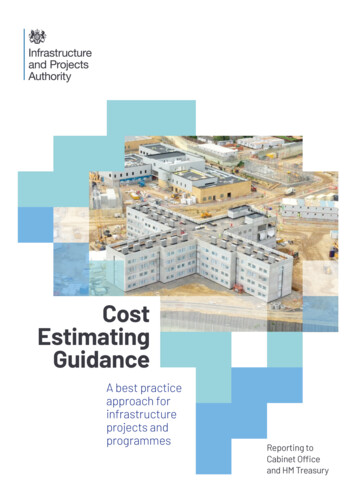
Transcription
CostEstimatingGuidanceA best practiceapproach forinfrastructureprojects andprogrammesReporting toCabinet Officeand HM Treasury
Cost Estimating Guidance ContentsForeword 1Introduction 2An overview of the cost estimating process 5Principles for best practice cost estimating 7Roles and responsibilities 12Cost estimating process 16Step 1: Establish brief and engage the team 17Step 2: Gather data and evidence 18Step 3: Select cost estimating methodology 20Step 4: Calculate base estimate, uncertainty,risk & opportunity 23Step 5: Produce cost estimate report 28Step 6: Review and assure 31Step 7: Project leadership sign-off 32Step 8: Use the cost estimate to support decision-making 33Cover image courtesyof Kier Group plcSummary 34Appendix 35Appendix A - Glossary 35Appendix B – Acknowledgements 38Appendix C - Useful documents 39
Cost Estimating GuidanceForewordThis government has an ambition to bringabout a revolutionary step-change in how itdelivers major projects. For this ambition tosucceed, we need a sustained focus on thecore principles of project delivery.Delivering major projects is always a challenge andeven more so during these unprecedented times.The Infrastructure and Projects Authority (IPA)is determined to ensure projects are set up forsuccess from the very start. These early decisionsoften determine the success or failure of a projectmuch further down the line and if done correctlywill ensure that projects deliver real benefits forpeople and communities across the UK.The cost estimate should be presented as a rangeto account for the level of risk and uncertaintyinherent in the project and this range shoulddecrease as the project develops.Central to project discipline is the use of expert,evidence-based cost estimates. Establishing anearly and accurate cost estimate is a key factorin selecting the right projects and delivering themon time and on budget.People - roles, skills and behaviours neededto deliver, assure and own the cost estimateHowever, a cost estimate is not a single figure thatis determined at the start of a project and fixedfrom therein. The cost estimate evolves over timeas the project matures and is inherently linked tothe development of the project scope and schedule.At the heart of developing a robust cost estimateof the three ‘P’s:Principles - of cost estimating to get the basicsright and address common pitfallsPerformance - steps for improving the qualityand consistency of cost estimates andsurrounding processesThis document sets out, for the first time, a bestpractice approach to cost estimating which shouldbe used by all major infrastructure projects andprogrammes in the UK. This guidance documentis for all project delivery team members includingSenior Responsible Owners and Project Directors.Nothing less than world class delivery will do andthis document is another step towards that vision,helping those involved in project delivery to thriveand deliver projects and programmes to thebenefit of all the citizens in the United Kingdom.Nick SmallwoodChief Executive, Infrastructureand Projects AuthorityInfrastructure and Projects Authority 1
Cost Estimating GuidanceIntroductionPEOPLEMANCNCIP LESIPAPERFORThe government is committed to transforming the wayinfrastructure projects are selected, procured and delivered.This guidance document sets out an expert, evidence-basedapproach to cost estimating which is critical to underpinsuccessful project delivery.PREIAbout this documentThis document sets out a best practiceapproach to the development of cost estimatesfor infrastructure projects and programmes.It is targeted at those involved in the sponsorship,leadership and delivery of projects to supportbetter quality project cost estimates andimproved decision making. Cost estimating process that should befollowed to produce a robust, assured andtransparent cost estimates which can be usedwith confidence to support successful delivery.This guidance document is part of a suite ofdocuments, including:Applying the IPA’s priorities of principles, peopleand performance this document covers: Principles for best practice cost estimatingoutlining the fundamentals that underpina good cost estimate to get the basics rightand address common pitfalls Roles and responsibilities in producing,reviewing and owning the cost estimateto make informed decisions Cost estimating guidance – setting out a bestpractice approach to cost estimation for allteam members Cost estimating requirements – a technicalguide setting out the detailed requirementsfor cost estimating teams and professionalsto produce and assure cost estimates Training – to support professional developmentand promote the adoption of consistent methodsFigure 1 – IPA’s Approach to improve cost estimating for NUALTRAININGMATERIALREQUIREMENTSGUIDESRO GUIDE(by CWEst)PRINCIPLESPERFORMANCEHOW YOUWILL DO THEESTIMATEHOW WE WILLASSURE THEESTIMATEHOW YOU WILLEVIDENCE THEESTIMATEPEOPLE2 Infrastructure and Projects Authority
Cost Estimating GuidanceIntroduction“ This guidance sets a precedentfor reliable cost estimating andwill further increase confidencein decision making, at a time whenwe are investing billions in theUK’s infrastructure.”How are cost estimates used?Cost estimates have many different uses, including: ecision making – underpinning the businessDcase at each stage gate (SG) in line withHM Treasury’s Green Book, supporting thecalculation of Cost-Benefit Ratios as well asaffordability and funding considerations Catherine LittleDirector General, Public Spending,HM Treasury ommercial – informing commercial strategiesCand enabling procurement of suppliersWhat is cost estimating? Control – a baselined, realistic cost estimatesets a key element of performance monitoringduring executionCost estimating is the process of forecastingthe financial and other resources needed tocomplete a project within a defined scope andschedule. A cost estimate is not a single figurethat is determined at the start of a project andfixed from therein. The cost estimate evolvesover time as the project matures and isinherently linked to the development of theproject scope and schedule. The cost estimateshould be presented as a range to account forthe level of risk and uncertainty inherent in theproject. This range should decrease as theproject develops.Setting up for successIPA’s eight principles1 for project success illustratesthe importance of investing enough time at very earlyproject stages, often referred to as front end loading.This is because the ability to impact the valuea project will deliver is greatest in its early stages,as illustrated in the graph below. The creation ofa robust cost estimate linked to an agreed scopeand schedule is a key factor in choosing the rightprojects and delivering them to cost and value.Figure 2 - The importance of setting the project up for successAt this stage,the costestimate.High levelof value/expenditure.determines.supportsproject viability optionassessment.incorporatesthe business caserequirements.supports earnedvalue calculations.validates estimateaccuracy and improvesfuture estimatesValueinfluence Low levelof ctbriefSOCOBCFBCFull updatedTime1 Principles of Project Success project-successInfrastructure and Projects Authority 3
Cost Estimating GuidanceIntroductionApproach to developing guidanceThe development of this best practice approachto cost estimating was informed by costestimating guides, industry reports, public andprivate sector practice and academic papers.In addition, this guidance has been developedand tested collaboratively with over 50 industryprofessionals and representatives, including anIPA-chaired panel comprising cost estimatingexperts, senior industry professionals andacademics, and the Cross-Whitehall CostEstimating Group (CWEst). IPA is grateful toall of these contributors for their support.ScopeThis guidance is focused on developing capitalcost estimates for government infrastructureprojects and programmes. Whilst some of theconcepts may be applicable more broadly,for example to non-infrastructure and nonconstruction projects, it has not been designedwith those in mind. Additionally, it does not focuson whole life cost, wider environmental (carbon,water footprint) or social outcome calculations.Whole life cost and carbon should be consideredat each stage of the life cycle along with the costestimate to inform project decisions.“ As one of the critical elements of project delivery, thisguidance on the development of cost estimates will helpmore projects to secure the right outcomes, particularlywhen used in conjunction with other best practice onsetting up projects for successful delivery.” Rachel SkinnerPresident, Institution of Civil Engineers4 Infrastructure and Projects Authority
Cost Estimating GuidanceAn overview of thecost estimating processCost estimating is the process of forecasting the financial andother resources needed to complete a project within a definedscope and schedule. Accurate and reliable cost estimates arecrucial to policy development, decision making and enableeffective delivery.Figure 3 The 8 steps of the costestimating process1Establish briefand engagethe team8Use the costestimate tosupportdecisionmaking2Gather dataandevidence3Select f6Reviewand assure45Produce costestimatereportCalculate basecost estimate,uncertainty,riskThe Cost Estimating Process is built as a cycleof eight steps (see Figure 3), summarised below,with more detail set out later on.Step 1: E stablish brief and engage the teamSet out clear requirements and identifythe right technical team to produce thecost estimate.Step 3: Select cost estimating methodologyGive a clear justification for thechosen methodology and revisitStep 2 if additional data is required.Step 2: Gather data and evidenceBuild an evidence base and documentkey assumptions.Infrastructure and Projects Authority 5
Cost Estimating GuidanceAn overview of the cost estimating processStep 4: Calculate base estimate,uncertainty and riskPrepare the Anticipated Final Cost anda range of possible values reflecting thelevel of risk and uncertainty inherent inthe project.Step 7: Project leadership sign-offEnsure the Project Director and SeniorResponsible Owner (SRO) understand thematurity of the cost estimate and acceptownership in preparation for stage gate(SG) review and approval.Step 5: Produce cost estimate reportDocument the methodology, assumptionsand evidence-base on which the costestimate is built and recommend priorityareas to reduce uncertainty.Step 8: U se the cost estimate to supportdecision-makingPresent the cost estimate as a rangeto account for the level of risk anduncertainty inherent in the project.Step 6: Review and assureConsider the appropriate type of reviewand level of assurance based on theimpact the cost estimate will have indecision-making and the risk of errorin the calculations. Revisit Step 4 if anerror is identified.At the centre of every cost estimate is the following equation:BaseestimateAnticipatedFinal CostUncertaintyRiskVariablerangeDelivering valueWhen followed consistently and supported by the requirements and assurance,this approach will enable higher quality cost estimates to be produced consistently.6 Infrastructure and Projects Authority
Cost Estimating GuidancePrinciples for best practicecost estimatingGet the basics of project costestimating rightThese principles set out the fundamentals thatunderpin a best practice approach to costestimating. Ensuring adherence to these principlesthroughout a project’s lifecycle will enable moresuccessful delivery.Further detail on each principle is set out below.Project leadership should ensure the right people,processes and technology are in place to fulfilthese principles.Clear ownershipRisk-adjustedThere is clear ownership andaccountability for the estimateThe estimates are risk-adjusted, presentedclearly and consistently, showing a rangeof possible outcomesRight skillsEvidence-basedThe estimate requires suitably qualifiedand experienced personnel anda collaborative environmentEstimates are transparent, robust anddata-based evidenceFront-end loadingReviewed and assuredInvestment to develop the project early ondrives better outcomes and enables moreaccurate estimates at every stageProject teams use review and assuranceto improve the quality of their estimateAppropriate methodContinuous improvementThe appropriate estimating methodevolves across project stagesAn approach to continuous improvementis essential to increasing the quality ofestimating practices and more generally“ Accurate cost estimating of rail investment projects is essentialin ensuring we develop and deliver good projects that best serveour passengers whilst making good use of investment funds.Setting a best practice standard for cost estimating will supportour teams provide guidance and ensure we take a consistentapproach on all our investment projects.” Stuart CalvertCapital Delivery Director, Network RailInfrastructure and Projects Authority 7
Cost Estimating GuidancePrinciples for best practice cost estimatingClear ownershipRight skillsClear ownership and accountability for the costestimate is fundamental to its reliability andbeing trusted as an input to decision-making.Projects must have the right people involvedin the cost estimation process at the right timeto deliver a robust cost estimate. Project leaders rely on cost estimatesto make informed decisions that havesignificant impact. The SRO must own thecost estimate and be accountable for its usein decision-making. All the team members interacting with thecost estimate from leadership, execution andassurance functions must understand thematurity of the cost estimate and factor thisinto decision-making. The cost estimate is not a supplementaryexercise but a fundamental part of the project.It is intrinsically linked to project scope,schedule, commercial arrangements, risksand mitigations and cannot be developedindependently from those decisions. The qualification, training and experiencerequired depends on the complexity of theproject and the cost estimating methodology. As project definition builds over time, criticalassumptions will evolve. Scope and schedulemanagement discipline underpin the reliabilityof the cost estimates. All individuals involved in the cost estimatingprocess must have clear responsibilities andthe accuracy of the cost estimate should bemonitored as a key performance metric forthe project.8 Infrastructure and Projects Authority The tools and techniques used to producereliable cost estimates often require specialistinput and expertise. A culture of challenge, trust and opennessunlocks collaboration, which improvesdecisions. A cost estimate produced in thisenvironment is likely to prove more accurateas its assumptions will be appropriatelychallenged and validated.
Cost Estimating GuidancePrinciples for best practice cost estimatingFront-end loadingAppropriate methodRobust planning, design and preparation in theearly stages of a project’s lifecycle are essentialin driving successful delivery.No single cost estimating method is appropriatefor the duration of a project’s development. Themethod should reflect the quality of availabledata and the level of project definition. The ability to impact the value a project willdeliver is greatest in its early stages throughsetting clear objectives and translating theseinto option selection and project requirements. Whilst successful project initiation can takemore time at the beginning, this will be repaidmany times over later on in delivery. Investmentto develop projects at an early stage has beenclearly linked to more accurate cost estimatesand improved outcomes. An investment of 3% to 5% of the project’stotal cost is expected prior to constructioncommencement. Early involvement of external stakeholders(e.g. Early Contractor Involvement (ECI) bothsupports and enables better cost estimates. The scale and complexity of the project affectsthe availability of high quality data. Repeatableassets should have access to mature cost dataand benchmarks, whereas novel, one-of-a-kindprojects may find a lack of available data. The cost estimating method used must reflectthe maturity of available data and the level ofproject definition. The cost estimating teamshould select the method that is most suitablebased on the information available. At each stage the cost estimate informsdifferent project decisions, the selectedmethods must cover the requirements ofthe project stage. Projects in earlier phases may be using a lessmature method whilst more advanced phasesmay have progressed, thus a mixture of methodsmay be in play at any given point in time. Early cost estimates should rely on top-downmethods such as analogy or scenario modelswhilst later stages should build on the detail ofthe project bottom-up, for example using firstprinciples or statistical modelling.Infrastructure and Projects Authority 9
Cost Estimating GuidancePrinciples for best practice cost estimatingRisk-adjustedEvidence-basedThe cost estimate should be presented asa range reflecting the level of risk anduncertainty at each stage.Cost estimating teams should report the datasources and processes used to develop the costestimate and ensure that the cost estimatecovers the full scope of the project. Decision makers need a clear understandingof the cost estimate, to make informeddecisions aligned to the project strategyand risk appetite. The cost estimate mustarticulate how it links to scope, design,schedule and risk. As a realistic view of the Anticipated Final Cost,the cost estimate must include an allocationfor risk and uncertainty. The cost estimate must always documentassumptions and exclusions. This enables theteam to understand the cost drivers and testfor sensitivity. A clear and consistent breakdown of thecost estimate supports comparisons acrossprojects. Projects must use a consistentcategorisation of costs to contribute toa shared body of knowledge. Cost estimates must present ranges of possibleoutcomes to articulate the level of confidencein the underlying calculations. The rangesshould narrow as the project and data matures.10 Infrastructure and Projects Authority Cost estimates are subject to scrutiny anddemonstrating the source of data improvesthe trust, reliability and repeatability in thecalculations and findings. The quality of thecost estimate is reliant on the maturity of theinput data and this must be communicatedto decision-makers. Critical assumptions and exclusions mustbe communicated and the working methodsmust be traceable to enable cost estimatetransparency. Tools and techniques such as benchmarkingand sensitivity analysis improve the robustnessof the cost estimate. Cost estimates must applyconsistent units, baselines and adjustment forinflation to ensure comparability throughoutproject stages. The level of maturity of the informationunderpinning a cost estimate must reachadequate maturity for the project stage(SOC, OBC, FBC) and type. A cost estimatereference class and attendant confidencelevel should be based upon the evidenced levelof maturity of scope development achieved,rather than having reached the stage gateapproval milestone.
Cost Estimating GuidancePrinciples for best practice cost estimatingReviewed and assuredContinuous improvementCost estimates that are reviewed and assuredappropriately will be improved and become morereliable, further driving project discipline.Capturing lessons learned and cost datafrom previous projects will improve futurecost estimates. Projects should set out their review andassurance regime at the start of the projectand validate it between stage gate approvals. Effective review and assurance build rigouraround the cost estimating process andincrease confidence in the cost estimate,enabling project leadership to make decisions. Projects should seek validation againststandard methodologies and peer review toenhance the cost estimating communitiesof practice. Internal and external/independent assuranceprogressively builds confidence, supportinga culture where the cost estimate is relied onand trusted. The cost estimate should be reviewed andvalidated in advance of each project stage gate;with changes in the cost estimate betweengates explained. Lessons learned from previous projects andretrospective evaluation of cost estimatesagainst actuals should be used to progressivelyrefine methodologies and assumptions. Checkpoints should be in place at each projectstage to identify differences and articulatethem in upcoming stage gate decisions. As projects apply a consistent approach anda robust methodology, they generate data thatshould inform evidence-based validation ofassumptions, increasing the maturity ofbenchmark and input data for delivery bodiesand across sectors. The cost and performance data used to compilethe cost estimate should be compared againstactual data during delivery to improve costintelligence in subsequent phases and projects.Infrastructure and Projects Authority 11
Cost Estimating GuidanceRoles andresponsibilitiesFigure 4 Cost estimatingroles and functionsOwn torTECOJPRPeople are at the heart of projectdelivery. Without suitably qualifiedand experienced personnel at eachstep of the project, the project is notlikely to be successfully delivered.This section outlines the key rolesand functions that interface withthe cost estimate.LEADERSHIPEQUIP OUR PEOPLE WITHTHE RIGHT KNOWLEDGEYERLIVDEPEOPLEAssurersDesign anddeliveryAssure theestimateProducethe estimateReviewersEstimating teamESTIMATING SPECIALISTSRoles and functionsRoles and functions can be broadly split into threecategories: those who produce the cost estimate,those who assure the cost estimate and those whoown the cost estimate: Produce – Project design, delivery and costestimating teams produce an effective costestimate by working in collaboration. Anychanges to the project scope or criticalassumptions should be effectivelycommunicated and controlled between thefunctions, and the cost estimating processshould inform technical decisions.12 Infrastructure and Projects AuthorityAssure – Reviewers and assurers undertakea robust review and independentassurance process.Own – Once the cost estimate has beenproduced, reviewed and assured, projectleadership consisting of the SRO and theProject Director accept ownership of thecost estimate to make significant decisionson the overall project. The SRO is ultimatelyaccountable for project performance in linewith the cost estimate.
Cost Estimating GuidanceRoles and responsibilitiesRole descriptionsProject leadershipAccounting OfficerRole descriptionTo assure Parliament and the public of high standards of probity in themanagement of public funds.ResponsibilitiesSafeguarding the public funds for which they are in charge in chargeAccounting Officer assessments as and when required(e.g. if the project departs from the agreed plan)Provide evidence to Parliament when called to accountSpecific interface withthe cost estimateAccountable in front of sponsor and controlling bodies representingHMG for the financial performance of the projectChallenge the SRO and Project Director on the project deliverablesMitigate the risk of management biases regarding the cost estimateSenior Responsible Owner (SRO)Role descriptionTo ensure the project delivers the business case benefits and outcomes.The SRO has ultimate accountability for the project.ResponsibilitiesChampion the project in the wider stakeholder environmentDefine outcomes and provide strategic directionOwn the business case and track benefits realisationManage the strategic risks and issues of the projectSpecific interface withthe cost estimateConfirm Go/No-go project progression considering the cost estimateand any review or assurance recommendationsReview, challenge and accept the cost estimate, understanding itscomponents, uncertainty and risk at each stage gateManage strategic risks to the project cost estimateExample qualificationsand experienceSRO FundamentalsMajor Projects Leadership AcademyExperience delivering major projectsInfrastructure and Projects Authority 13
Cost Estimating GuidanceRoles and responsibilitiesProject deliveryProject DirectorRole descriptionTo ensure that the project is delivered and objectives are achieved withinthe agreed time, cost and quality constraints.ResponsibilitiesManage and lead the project on a day-to-day basisDevelop the business caseTrack delivery within budgetWork with the SRO to manage senior stakeholders (e.g. Project Executive)Create the project delivery culture and behaviours supportingsuccessful deliverySpecific interface withthe cost estimateChallenge the cost estimate for robustness and understand sensitivitiesEnsure the cost estimate is produced in line with project requirementsReview the critical assumptions periodically to ensure they align to thereality of the projectManage risks to the cost estimate and overall projectExample qualificationsand experienceChartered Project Professional (ChPP)Major Projects Leadership AcademyPRINCE2 Practitioner / Agile Project ManagementRICS FellowProject Design and Delivery TeamRole descriptionResponsibilitiesTo ensure that the objectives are clearly defined and achieved withinthe agreed time, cost and quality constraints.Delivery of the day-to-day project activitiesRaise and manage risks and issuesRegular reporting and tracking of progress against planSupport the Project Director in meeting their obligationsSpecific interface withthe cost estimateProvide a clear view of assumptions to cost estimatorsEstablish a change control process to ensure changes, assumptionsand scope additions are considered and reflected in the cost estimateProvide relevant cost-related information to estimatorsSeek and present appropriate benchmarking informationExample qualificationsand experienceAPM Project Management Qualification/Practitioner QualificationExperience delivering a large project14 Infrastructure and Projects Authority
Cost Estimating GuidanceRoles and responsibilitiesCost estimate specialistsCost Estimating TeamRole descriptionTo produce a cost estimate based on the scope, assumptions andexclusions agreed with the project team.ResponsibilitiesReport progress against the plan to the Project DirectorLiaise with project delivery team on an ongoing basisEngage Subject Matter Resources to provide guidance when requiredSpecific interface withthe cost estimatePropose and document the cost estimation methodologyProduce the cost estimate as per the methodologyCollect evidence clearly and consistently aligned to the costbreakdown structurePrepare evidence material for reviewers and assurersCapture data as input and outputExample qualificationsand experienceExperience using cost estimating toolsExperience producing cost estimatesRICSIncorporated Cost EngineerCertified Professional Cost EngineerReviewers and AssurersRole descriptionTo review the cost estimate and provide assurance that the cost estimateis robust and accurate.ResponsibilitiesLiaise with project reviewers and assurers to ensure alignmentReport risks and issues identified to the Project Delivery Team/Project DirectorSpecific interface withthe cost estimateConduct independent internal reviews of the cost estimate at eachstage of the projectConduct independent external reviews of the cost estimate at eachstage of the projectProduce a summary report of the risks and issues with the cost estimateExample qualificationsand experienceCertified Professional Cost EngineerExperience developing cost estimatesExperience reviewing cost estimatesIPA Accredited ReviewerInfrastructure and Projects Authority 15
Cost Estimating GuidanceCost estimating processProducing robust, assured and transparentcost estimates is fundamental to drivingworld class project delivery. The costestimating process is embedded incontinuous improvement methodologyand thus is not necessarily linear.This section outlines an approachframework to producing cost estimateswhich have improved accuracy, throughclear accountability and consistent datacapture across sectors.The approach performance frameworkis built as a cycle of eight steps. Therequirements guide provides further detailon the expected process and checks thatpractitioners must perform at each step.1Establish briefand engagethe team8Use the costestimate tosupportdecisionmaking2Gather dataandevidence3Select f6Reviewand assure45Produce costestimatereportCalculate basecost estimate,uncertainty,riskFigure 5 - Cost estimating performanceframeworkAt the centre of the cost estimating process liesa shared conceptual understanding of the costestimate presented as an anticipated final costwith a variable range to assert the confidencearound it, built out of the component parts ofevery cost estimate:Base cost estimate – a position of the mostlikely cost of each component based onavailable data Uncertainty – the sensitivity aroundassumptions, tied to the maturity of theproject definition Risk – acknowledging the impact of probabilitydriven events16 Infrastructure and Projects Authority
Cost Estimating GuidanceCost estimating process18376Step 1: Establish brief and engage the team254Understand project brief outcomesDriving behavioursEstablishing a full project brief and settingclear objectives at the outset of the project andat the start of each stage gate cycle is an importantstep in producing a robust cost estimate. Theproject brief information should provide a clearunderstanding of the context and requirements ofthe cost estimate. This will inform the appropriateresource considerations,
Cost Estimating Guidance Contents Foreword 1 Introduction 2 An overview of the cost estimating process 5 Principles for best practice cost estimating 7 Roles and responsibilities 12 Cost estimating process 16 Step 1: Establish brief and engage the team 17 Step 2: Gather data and evidence 18 Step
